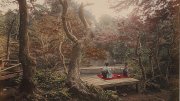Under the shade of red-leafed maples, a woman in a blue kimono sits on a platform beside a river, while a serving girl holds a tea set. In the distance: a footbridge with a lone pedestrian. “Oji, Tokio (maple),” the title reads, referring to a bucolic area of the Japanese capital. The image is beautiful and perplexing—realism tinged with surreal pops of color.
Dating to about 1890, it is one of more than 5,000 hand-painted photographs that collector E.G. Stillman, A.B. 1908, brought home from Japan and donated to Harvard in the 1940s. Some were photographs he likely took himself, but most were professional prints sold in curio stores as souvenirs for the growing number of Western tourists.
The practice of hand-colored photography was introduced in Europe during the 1840s but perfected by Japanese artists, says Joanne Bloom, photographic resources librarian at Harvard’s Fine Arts Library, which houses much of the Stillman collection (the rest is at Widener Library and Harvard-Yenching Library). Most of these images started out as monochrome albumen prints produced on paper coated with a light-sensitive egg-white emulsion and salt. In a tedious, delicate process, artists added colors with water-soluble paints and, later, synthetic dyes. Made during the late 1800s and early 1900s, the Stillman photographs capture life during the Meiji period, when rapid modernization was underway but had not yet transformed society.
“The Old Japan as it will never appear again,” reads an inscription in one of Stillman’s photo albums. The progeny of industrial and banking tycoons, Stillman was a medical researcher and a lifelong “Japonist” who first visited in 1905. The photographs he brought back from that trip and others show workers in a rice paddy, a farmer with a packhorse, villagers, singing children, teahouses, temples, brothels, kimono-clad musicians, and a man walking a remote path, with Mount Fuji rising in the distance. These images seem both hyper-real and hazily fantastical—bright glimpses of a vanishing world.









